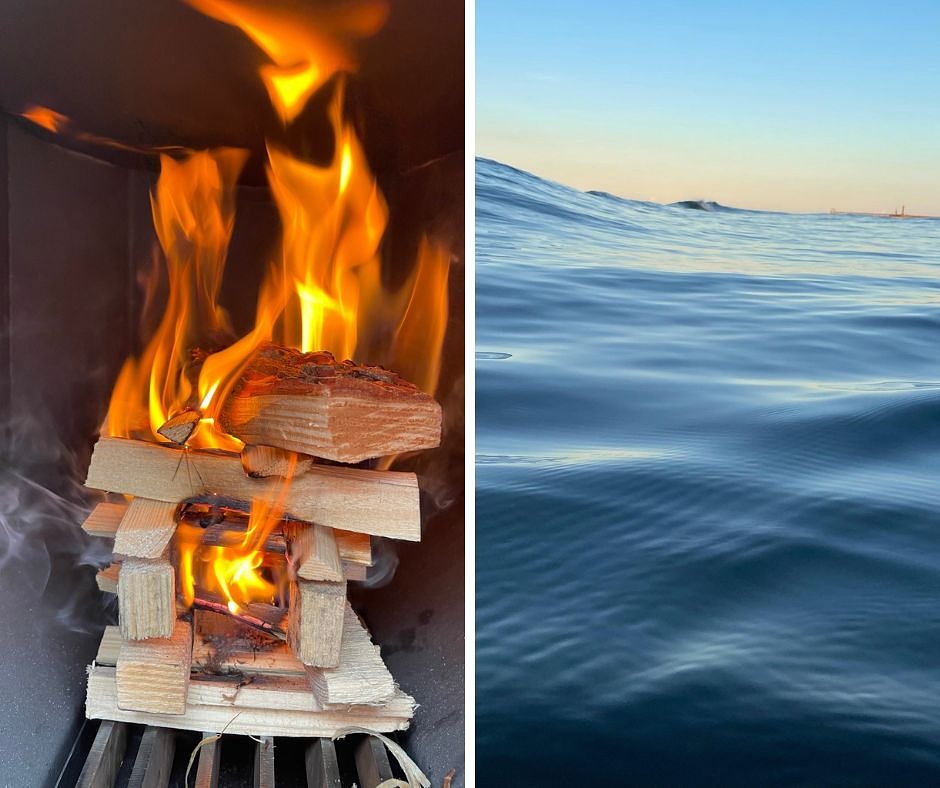Hot and cold temperatures make a contrast for therapy
Whitby Wellbeing offers a blend of using wood-fired sauna heat and cold-water dipping and people love the hot and cold combination.

Posted on Wed 7 Dec 2022 · by Jennifer Robson
The contrast helps the body releases endorphins and people leave the sessions exhilarated but super-chilled.
This contrast therapy, which involves experiencing alternating warm and cold temperatures, is a technique that has been used for over 2,000 years dating back to ancient Romans who built bath houses with steam rooms, hot tubs, and cold baths.
It is thought to improve blood circulation throughout the body, and help conditions like oedema, stiff joints, inflammation of soft tissues, muscle spasms, and painful limbs.
It is popularly used by athletes, who use it to treat muscle damage, sore or painful muscles, and to speed up recovery after injuries, but anybody can enjoy and benefit from contrast therapy.
As well as the whole body, contrast therapy may be used on the hands, wrists, forearms, elbows, feet, knees, ankles, and lower legs.
There have been a few studies done around its beneficial effects for recovery, strength, overcoming pain, and overall performance.
Reduces fatigue and speeds up recovery
When submerging in warm water capillaries, the small blood vessels, respond to the heat by opening and expanding.
By then immersing in cold water, the capillaries retract, resulting in the alternating of blood flow to the internal organs and extremities.
This helps remove by-products produced by high-intensity exercise, increases the efficiency of the body’s natural recovery process, helps alleviate post-game fatigue.
Research has found contrasting hot and cold baths helped sports players recover from fatigue 24 to 48 hours after the game. Immersion in cold water alone didn’t provide the same benefit.
Increases concentration
Contrast therapy offers the opportunity to rejuvenate the mind while relaxing. The combination of heat and cold helps improve overall mental state, overcomes ‘brain fog’, allowing you to reach maximum clarity of mind and concentration. Contrast therapy can also enhance sleep and provide an overall sense of wellbeing.
Decreases pain and soreness
Contrast therapy is great for anyone suffering aches, pains, and tensions in the muscles.
Using a mixture of hot and cold treatments, contrast therapy helps reduce muscle inflammation and swelling, and repairs and rebuilds damaged muscles. It also encourages fast recovery time following exercise.
It’s particularly effective to alleviate soreness after intense exercise. This can cause damage to your muscle fibres, but you might not feel sore until a day or so later. This is called delayed onset muscle soreness (DOMS).
Researchers measured both DOMS and muscle weakness in elite athletes following strenuous workouts and found contrast therapy improved both the soreness and weakness better than passive resting alone. The best results happened when the hot water temperature was below 104°F (40°C).
Lessens swelling
When injured, part of the body’s normal inflammatory response is a rush of fluid and white blood cells to the affected area. The build-up of this fluid can exert pressure on the injury and cause further pain.
There is some evidence that contrast baths reduce swelling. This study involving 115 people with ankle sprains, showed contrast hydrotherapy reduced swelling around three days after injury.
Improves range of motion
Injuries, joint inflammation, or a pulled muscle, can all significantly decrease range-of-motion of the affected joint or muscle. Contrast therapy reduces swelling to improve and increase the limited range of motion and movement.
Removes excess lactic acid
When we exercise vigorously, lactic acid builds up throughout the body. This accumulation of lactic acid is normal, but it can make you feel tired and sore.
You can ease the symptoms of lactic acid build up in your body by resting, drinking water, taking a magnesium supplement, and following a few other simple protocols.
A study conducted in 2007 showed contrast therapy can help decrease the lactic acid in your body, helping you swiftly recover from the soreness and fatigue of strenuous exercise.
Boosts strength
Contrasting between cold and hot temperatures has also been found to increase muscle strength post-recovery.
This article shows that athletes using contrast therapy had a higher 1-rep max on a leg press, more muscle power as measured by isometric force, and performed better on a jump squat compared to recreational athletes who weren’t receiving the therapy.
Contrast therapy FAQs
- The key to contrast therapy is in the swift changes produced in the circulatory system when going from very cold conditions to very hot conditions.
- Stay hydrated. The quick temperature changes can lead to dehydration.
- Don’t drink alcohol or use recreational drugs before, during, or after contrast therapy.
- Like anything, contrast therapy should be discussed with a doctor particularly if there are outstanding health issues such as heart issues, high blood pressure,
- deep vein thrombosis, or diabetes.
- Check with your doctor if you’re pregnant or planning to become pregnant, before participating in contrast therapy.
Now read our summary of cold water benefits and our blog about saunas!
Ready to dive in? Contact us.